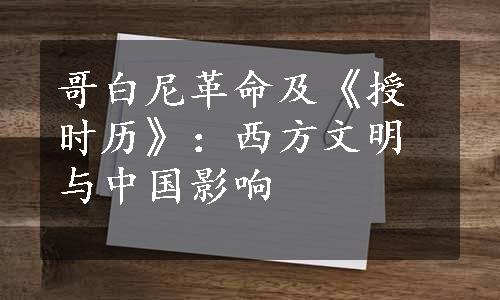
鉴于托勒密《天文学大成》是伪造的,所以包括该书在内的近代早期的西方所有的相关成就,都不能不是来自中国的,都是《授时历》的“爆炸性效应”。它们包括哥白尼的日心说、《格里高利历》和斯卡利杰所设计的“古代历法”。
科学史不在其自身,它倚靠“尽精微而致广大”的道的智慧和亘古文明,若无后两者,纵然把“科学传统”说得天花乱坠(例如古希腊),那只能是子虚乌有。在1492年之后,全球已被打通,有着极大的“生态缓冲”,所以,科学能够“独当一面”。而在之前,人与自然是生命攸关,动辄自毁家园,所以科学必需“因道而生、遵道而行”。
以下是董并生所写《哥白尼“日心说”来源于中国》[86]的节录:
按照孟席斯的说法,“哥白尼革命”应该改为“郭守敬革命”。
哥白尼的理论直接来自雷乔蒙塔纳斯(Regiomontanus),而雷乔蒙塔纳斯的天文学知识则源于中国元朝郭守敬的《授时历》。
哥白尼认为,“地球每天绕自己的轴自转,每年绕静止的太阳公转”,这是雷乔蒙塔纳斯书中的话。芝加哥大学教授诺埃尔·斯瓦德罗的研究论文《哥白尼行星理论初稿与起源》称……大约从1504年起,哥白尼已在波隆那获得雷乔蒙塔纳斯的《星历表》和《天文学概要》……之后,哥白尼采用雷乔蒙塔纳斯的《概要》第十一卷,其中包含导致哥白尼的革命性理论的分析。
比较郑和的《星历表》与雷乔蒙塔纳斯的《星历表》,我们可以大概了解到雷乔蒙塔纳斯透过托斯卡内利(而不是希腊天文学家),从中国人那儿继承的一部分东西。……青纳等人宣称,雷乔蒙塔纳斯的《星历表》是使用经过观测后修正的阿方索星表的结果。如果雷乔蒙塔纳斯的《星历表》根据阿方索星表,那么,它们将无法测定太阳、月球和行星的位置,也少了足够的精确度来预测日月食乃至经度。因为阿方索星表是奠基于一个完全错误的宇宙体系,它把地球当成宇宙的中心,行星绕地球转动。
雷乔蒙塔纳斯很了解,用旧的阿方索星表是无益的。他在自己的1475—1531年历书中指出,阿方索星表里的1475—1531年的56年间,有30年的复活节(在天主教教会里最重要的一天)的日期是错误的……
郑和的《星历表》则是以郭守敬为基础……在雷乔蒙塔纳斯去世后多年,哥伦布、韦斯普奇等人真的利用雷乔蒙塔纳斯的《星历表》来预测日月食、纬度和经度……雷乔蒙塔纳斯一定从托斯卡内利那儿获得他的资料……
自1474年雷乔蒙塔纳斯的《星历表》出版后,欧洲人首次可以计算纬度和经度,知道他们在海上的位置,到达新世界,精确地将它标示在图上,并且安全地返回家园——这是一场海洋探险的革命。
中国的天文学才是欧洲近代天文学的基础。欧洲近代天文学的来源既不是古希腊,也不是托勒密。
正如在1434年之后,亚里士多德—托勒密的宇宙规范被束之高阁。郭守敬的赤基黄道仪——欧洲现代仪器如天文罗盘的先驱——至今尚存于世。从那时开始,欧洲天文学家就仿效中国的方法。
1434年《授时历》传入欧洲,经过百余年的发酵,到1543年由哥白尼“发扬光大”于《天体运行论》,对欧洲的神学体系产生了巨大冲击。
从文艺复兴之“人文主义”开始,欧洲人的世界观和方法论,无不打上中国烙印。达·芬奇绘制的大量“机械制图”和提出的“机械原理”,都是源于中国元代的《农书》,后者在天文、物理、光学、数学、医学、建筑、军事、水利、地质学、生物学等领域,对近代科学的形成产生重大影响。哥白尼的“日心说”源于中国元朝的《授时历》,对于西方宇宙观的影响既深且久。
【注释】
[1]https://www.coursehero.com/file/p69fufb/Medieval-men-also-had-no-sense-of-time 12 Sept.2005.
[2]Shulamith Shahar,Yael Lotan:Growing Old in the Middle Ages:Winter Clothes Us in Shadow and Pain,London:Routledge,2004,p.29.
[3]Alaric Hall:Interfaces Between Language and Culture in Medieval England,Leiden:Brill,2010,p.207.
[4]Peter Burke:The Renaissance sense of the past,Edward Arnold,1969,p.1.
[5]Thomas F.Glick:Medieval Science,Technology,and Medicine:An Encyclopedia,NY:Routledge,2005,p.128.
[6]Friedrich G.Barth:Sensory Perception:Mind and Matter,NY:Springer,2012,p.372.
[7]David Curtis Wright:The History of China,Greenwood Press,2001,p.42.
[8]World Mysteries,October 12,2012.http://blog.world-mysteries.com/science/ancient-chinese-inventions-and-discoveries-that-shaped-the-world/%EF%BC%8COctober%
[9]A history of Zero,http://www-history.mcs.st-and.ac.uk/HistTopics/Zero.html
[10]The Human Being,Aliran Kesedaran Negara,1991,p.151.
[11]A.C.Crombie:Science,Optics,and Music in Medieval and Early Modern Thought,London:the Hambledon Press,1990,p.23.
[12]A.Fomenko:History:Fiction or Science?Chronology 1,p.465—467.
[13]杨大傻:《数学符号中的“0”起源于哪个国家?》,天涯问答。
[14]Erik Kooper:The Medieval Chronicle,Rodopi,1999,p.137.
[15]James GARDNER:Repertory of Biblical and Theological Literature,Johnstone & Hunter,1855,p.285.
[16]Bricker:Reformed and Catholic,Wipf and Stock Publishers,1979,p.194—195.
[17]Henry J.Perkinson:How Things Got Better:Speech,Writing,Printing,and Cultural Change,Bergin & Garvey,1995,p.92—93.
[18]Eric Jorink:Reading the Book of Nature in the Dutch Golden Age,1575—1715,p.103.
[19]Jonathan Z.Smith:Relating Religion:Essays in the Study of Religion,the University of Chicago Press,2004,p.314.
[20]Daniel Lord Smail:On Deep History and the Brain,University of California Press,2008,p.22.
[21]Grant Berkley,Baram Blackett,Alan Wilson,J.:Moses in the Hieroglyphs,Trafford Publisher,2006,p.32.
[22]Eric Jorink:Reading the Book of Nature in the Dutch Golden Age,1575—1715,Leidon:BRILL,2010,p.103.
[23]Is a Chunk of History Missing?https://www.uwgb.edu/dutchs/PSEUDOSC/Phantom%20Time.HTM
[24]Richard Henry Popkin,Arie Johan Vanderjagt:Cepticism and Irreligion in the Seventeenth and Eighteenth Centuries,Leiden:Brill,1993,p.151.
[25]Mark Goldie,Robert Wokler:The Cambridge History of Eighteenth-Century Political Thought,Cambridge University Press,2006,p.223.
[26]Florin Diacu Mathematical Methods in the Study of Historical Chronology,http://www.chronologia.org/en/2013_florin_diacu.html
[27]Investigation of the Correctness of the Historical Dating by Wieslaw Z.Krawcewicz,Gleb V.Nosovskij and Petr P.Zabreiko,http://www.world-mysteries.com/sci_16.htm
[28]186 A Brief History of the"Phantom Time"Delusion and its Main Advocates by Gary D.Thompson,http://members.westnet.com.au/gary-david-thompson/page9bb.html
[29]Joseph Wheless:Forgery in Christianity,Pomeroy:Health Research Books,1996,p.71.
[30]NEW RADICAL CHRONOLOGY:THE ULTIMATE PROOF,www.theflatearthsociety.org/forum/index.php?topic=30499.msg1638504#msg1638504
[31]Ronald M.Clancy:Sacred Christmas Music:The Stories Behind the Most Beloved Songs of Devotion,NY:Sterling,p.21.
[32]Oùest donc passéle Moyen-Âge?L'invention de l'ère chrétienne.
[33]A.Fomenko:History:Fiction or Science?Chronology 1,p.359—360.
[34]C.Philipp E.Nothaft:Dating the Passion,Brill,2012,p.1.
[35]Jonathan Hill:Faith in the Age of Reason,A.Lion Book,2004,p.118.
[36]A.Fomenko:History Fiction or Science?Chronology 1,p.360.(www.daowen.com)
[37]A.Fomenko:History Fiction or Science?Chronology 2,p.229.
[38]The New Complete Works of Josephus,Grand Rapids:Kregal Publications,1999,p.1077.
[39]The Works of Flavius Josephus by William Whiston,Grand Rapids:Kregal Publications,1993,p.1006.
[40]How did Gomarus acquire the copy of Flavius Josephus in Greek from Scaliger's library?Dutch Review of Church History Vol.77,No.2(1997),p.258—266.
[41]The New Complete Works of Josephus,p.1077.
[42]W.White's catalogue,London:1844,p.142.
[43]A.Fomenko,Gleb V.Nosovskiy.“History:Fiction or Science?”.Chronology 4.-Delamere Publishing,Paris,London,New York,2007,p.580.
[44]A.Fomenko:History Fiction Or Science.Chronology 2,p.272.
[45]Flavius Josephus as a created interpolation on Joseph Scaliger,http://ajendu.blogspot.co.uk/2015_06_01_archive.html
[46]The Jesus Forgery:Josephus Untangled by Acharya S/D.M.Murdock.
[47]The Phantom Time Hypothesis,by the Church.by Brian Dunning,October 16,2012.https://skeptoid.com/episodes/4332
[48]Phantom time hypothesis From Wikipedia,the free encyclopedia.
[49]https://skeptoid.com/episodes/433
[50]Philip Coppens:Preparing for the New Age of Egypt.
[51]Henry Hallam:Introduction to the Literature of Europe,Vol.2,London,1860,p.77.
[52]Donald F.Lach:Asia in the Making of Europe,Volume II:A Century of Wonder.Book 3,the University of Chicago Press,1977,p.64.
[53]Donald F.Lach:Asia in the Making of Europe,Volume II:A Century of Wonder.Book 3,p.414.
[54]David B.Honey:Incense at the Altar,American Oriental Society,2001,p.4.
[55]Ram Nath Sharma,Rajendra K.Sharma:Anthropology,Delhi:APD Computer Grahpics,1997,p.199.
[56]James Hastings:A Dictionary of the Bible:Volume I(Part II:D—Feasts),University Press of the Pacific,2004,p.657.
[57]Joe Moshenska,Joseph Moshenska:Feeling Pleasures:Sense of Touch in Renaissance England,p.298,note 42.
[58]The Skeptical Inquirer,Committee for the Scientific Investigation of Claims of the Paranormal,p.285.
[59]R.L.Reese,S.M.Everett,and E.D.Craun,The origin of the Julian Period,Amer.J.Phys.49(1981),658—661.
[60]Christopher Kelly:Rousseau as Author:Consecrating One's Life to the Truth,the University of Chicago Press,2003,p.144—145.
[61]Ram Nath Sharma,Rajendra K.Sharma:Anthropology,Delhi:APD Computer Grahpics,1997,p.199.
[62]John Jackson:Chronological Antiquities,Vol.Ⅱ,London,1752,p.65—66.
[63]Timothy Brook,Gregory Blue:China and Historical Capitalism,68.
[64]Cécile Leung:Etienne Fourmont(1683—1745),Leuven University Press,2002,p.120—123.
[65]Luís Saraiva:Europe and China:Science and Arts in the 17th and 18th Centuries,World Scientific Publishing,Co.,2013,p.72.
[66]Sarah Knight,Stefan Tilg:The Oxford Handbook of Neo-Latin,Oxford University Press,2015,p.566.
[67]Joseph P.McDermott,Peter Burke:The Book Worlds of East Asia and Europe,HK University Press,2015,1450—1850:Connections and Comparisons,p.259.
[68]DonaldK.Sharpes:Advanced Educational Foundations for Teachers,NY:Routledge,2002,p.213.
[69]Clerks and Craftsmen in China and the West,Cambridge University Press,1970,p.5.
[70]The Papacy and Ancient China by Tai Peng Wang.
[71]孟席斯:《1434》,第34—35页。
[72]Mark Somos:Secularisation and the Leiden Circle,Leiden:Brill,2011,p.49.
[73]The Julian Period,www.pauahtun.org/Calendar/julian_period.html
[74]THE PHANTOM TIME HYPOTHESIS,www.damninteresting.com/the-phantom-time-hypothesis/
[75]http://www.theflatearthsociety.org/forum/index.php?topic=65798.0#.VvFUzPlmSlV
[76]N.Eliopoulos:Jugoslavia and World Peace,Writers Club Press,2002,p.151.
[77]I.Gershevitch:The Cambridge History of Iran,Vol.2,p.765,n.2.
[78]Postgresql Global Development Group:PostgreSQL 9.0 Official Documentation-Volume V.2011,p.206.
[79]The Julian Period,www.pauahtun.org/Calendar/julian_period.html
[80]Sacha Stern:Calendars in Antiquity,Oxford University Press,p.217.
[81]THE CHRONOLOGY ISSUE,www.bookmasters.com/marktplc/01098.htm
[82]A.T.Fomenko:History,Fiction Or Science?p.xv.
[83]Renaud Morieux:The Channel,Cambridge University Press,2016,p.98.
[84]中文百科在线,http://m.zwbk.org/lemma/126774
[85]Brian Nugent:A Guide to the 18th Century Land Records in the Irish,Corstown,2013,p.31.
[86]该文是董并生的读书笔记,载于董并生新浪博客。
免责声明:以上内容源自网络,版权归原作者所有,如有侵犯您的原创版权请告知,我们将尽快删除相关内容。






